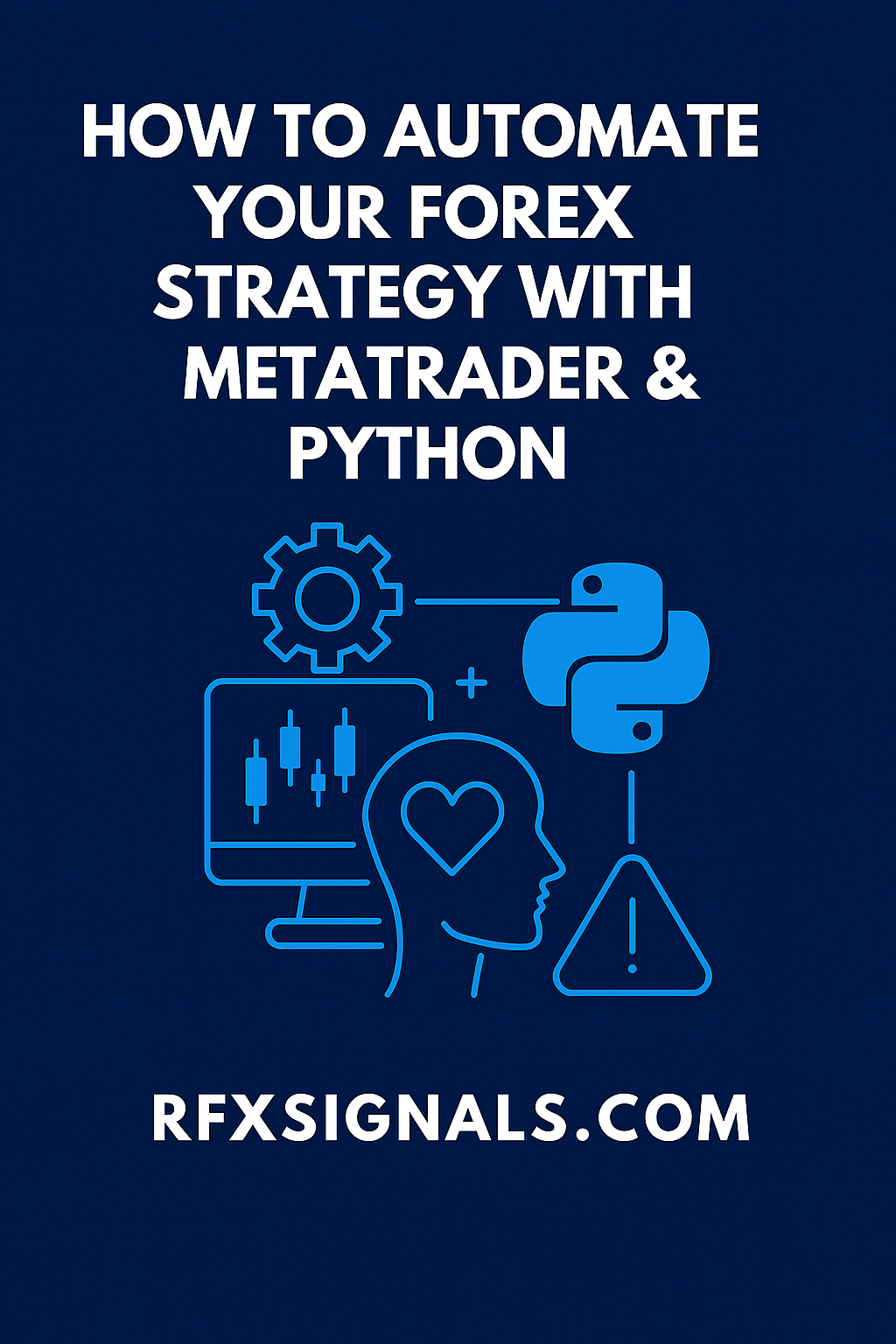
How to Automate Your Forex Strategy with MetaTrader & Python
By RTech RFX Signals ·
Learn a practical, step-by-step approach to automating Forex strategies using MetaTrader (MT4/MT5) for execution and Python for research, backtesting and orchestration. Includes data handling, risk controls and deployment tips.
Introduction — why automate?
Automation eliminates manual errors, enforces discipline and enables systematic execution at scale. With MetaTrader (MT4/MT5) handling execution and Python powering research, signal generation and orchestration, traders can move from ideas to reliable, repeatable strategies. This guide covers the full workflow: data, development, backtesting, execution, monitoring and governance.
Overview: Roles of MetaTrader and Python
MetaTrader is battle-tested for retail FX execution: order types, broker connectivity, and built-in charting. Python excels at data science: feature engineering, machine learning, and robust backtesting libraries. The typical split:
- Python: data ingestion, feature engineering, signal generation, optimization, and backtesting (pandas, numpy, scikit-learn).
- MetaTrader: live order execution, order management, stop/take logic and broker connectivity via MQL or bridge software (e.g., MetaTrader-Python packages).
Step 1 — design your strategy & define rules
Document the strategy precisely: entry conditions, exits, stops, money management, maximum exposure and behavior during news/events. Write pseudo-code or a flowchart — automation is easier and safer when rules are unambiguous.
Example rule set
Example: "Long EURUSD when 50-period SMA > 200-period SMA and RSI(14) < 30. Exit at TP=30 pips or SL=20 pips, max 2% account risk per trade."
Step 2 — gather and clean data
Use high-quality historical data for backtesting. MetaTrader provides broker-specific history, but for robust research use consolidated tick or minute data from reliable vendors. Key steps:
- Download tick/minute OHLCV; align timezones (MT uses broker time).
- Clean missing bars, remove duplicates and correct daylight-saving shifts.
- Store in compressed, queryable formats (Parquet/Feather) for Python processing.
Step 3 — research & backtest in Python
Python lets you rapidly prototype. A recommended stack:
- pandas / numpy for data manipulation
- bt / zipline / vectorbt or custom engines for backtesting
- scikit-learn / xgboost / lightgbm for models
Backtesting best practices: use time-aware cross-validation (walk-forward), realistic slippage & spread models, include commissions, and simulate order execution granularity. Never shuffle time-series during CV — that leaks the future.
Step 4 — create a bridge between Python and MetaTrader
There are several options to send signals to MetaTrader:
- Native MQL: rewrite logic as an Expert Advisor (EA) in MQL4/MQL5 for direct execution inside MT. Good for latency-critical strategies.
- Python↔MT bridges: Use packages like MetaTrader5 (official Python package) or third-party bridges (zeroMQ endpoints, WebSockets, or REST middlewares) to send signals from Python to MT. This preserves Python’s ecosystem for research while MT handles orders.
- FIX/API providers: For institutional needs, use broker APIs or FIX gateways to bypass MT entirely.
For most retail traders, the Python-to-MT bridge offers the best mix of flexibility and execution control.
Step 5 — implement order management & risk controls
Hard-code risk rules in the execution layer. Do not rely on the research script alone. Important controls:
- Max percent risk per trade and per instrument
- Max daily drawdown kill switch
- Slippage limits and fill verification
- News blackout windows
Implement these both in Python (pre-send checks) and in MQL/EA (pre-order checks) for redundancy.
Step 6 — test with paper / demo accounts
Always run the integrated system on a demo account for extended periods (30–90 days) under live market conditions. Measure real slippage, spreads, execution delays, and unexpected behavior. Logging is critical — record every signal, order request, broker response and fill detail for post-trade analysis.
Step 7 — deploy to live with monitoring & governance
When moving live:
- Start with small capital and scale gradually.
- Implement real-time monitoring dashboards (profit, drawdown, active orders, latency).
- Maintain an automated alerting system for anomalies and failed orders (email, WhatsApp, webhook to Ops).
- Keep a human-in-the-loop kill switch to pause trading instantly.
Practical code snippets & libraries
Quick pointers:
- MetaTrader5 Python package: official package to connect to MT5 from Python (fetch history, send orders). Good for research & sending market orders. (See MetaTrader docs.)
- zeroMQ / WebSocket bridges: for low-latency signal delivery between Python services and an EA inside MT.
- vectorbt: lightweight backtesting & analytics for rapid prototyping.
Example (high-level) — Python sends a JSON order to a local bridge which the EA reads and executes:
// Python: send order
payload = {"symbol":"EURUSD","side":"buy","lots":0.1,"sl":-0.0002,"tp":0.0030}
requests.post("http://localhost:5000/send_order", json=payload)
// EA receives and executes with safety checks
Common pitfalls & how to avoid them
- Ignoring latency: measure end-to-end latency and its effect on fills.
- Overfitting: don’t over-optimize parameters to historical quirks.
- Lack of redundancy: ensure logs, monitoring and fallback execution paths exist.
- No rollback plan: have a procedure for failed orders and data corruption.
Security and operational considerations
Secure your automation: protect API keys, run services on trusted VPS, use TLS for any network communications, and restrict access with firewalls. Version-control your strategy code and document changes — maintain an audit trail for every deployment.
Scaling & next steps
As you scale, consider: more robust execution via VPS co-location, a time-series database for high-frequency logging (InfluxDB/Timescale), and orchestration (Kubernetes) for multiple strategy instances. For more advanced research, use GPU-enabled training for ML models and store features in feature stores for reproducibility.
Conclusion
Automating a Forex strategy with MetaTrader and Python is a practical, powerful approach when done methodically. Define clear rules, use high-quality data, backtest with realistic execution models, bridge Python to MT with safe order handling, test extensively on demo accounts, and deploy with robust monitoring and kill-switches. Start small, document everything, and treat automation as engineering — not magic.
Ready to automate? Get our starter pack
Download a demo Python↔MetaTrader bridge example, sample EAs, and a checklist to move from paper to live safely.
Further reading (authoritative outbound links)
Official doc resources: MetaTrader 5, Python, and packages: MetaTrader5 Python package.